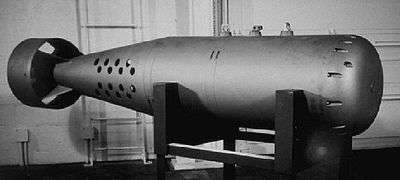Mk 101 Lulu

The Mark 101 Lulu was an air-dropped nuclear depth bomb (NDB) developed by the United States in the 1950s. It utilized a W34 nuclear warhead, with a yield of about 11 kilotons. It was deployed by the United States Navy for the purposes of anti-submarine warfare, in five different models, from 1958 until 1971. Weapons were also stockpiled at overseas allied bases under American military guard for use by maritime aircraft of NATO allies, notably at RAF St. Mawgan, Cornwall, for use by Royal Air Force Avro Shackleton aircraft, and the Dutch Navy P-2 Neptune and P-3 Orion aircraft. The Mk-101 "Lulu" began to be replaced by the multi-purpose B57 nuclear bomb in the mid-1960s. The B-57 was a bomb that could be used by tactical strike aircraft in a land warfare role, as well as a nuclear depth bomb. The Mk-101 "Lulu" had a length of 7 ft 6 in (229 cm), diameter of 1 ft 6 in (46 cm), and weighed 1,200 lb (540 kg). In RAF service for carriage by Shackleton MR2 and MR3 maritime patrol bombers it was known as Bomb, AS, 1200 lb, MC.
This weapon lacked an important safety/arming device, i.e., there were no sensors to detect free-fall from an aircraft which would result from the bomb being intentionally dropped in flight. As a result, if an armed Mk 101 bomb accidentally fell off an aircraft whilst it was parked on the flight deck of a warship and then rolled overboard, it could automatically detonate when it sank to the preset depth.[1]
The W34 boosted-fission warhead used in the Mk-101 "Lulu" was also used in several other similar weapons, and a version referred to as "Peter" was used as a thermonuclear primary in the British Yellow Sun and as the "Python" in the U.S. (the B28 nuclear bomb).
References
- ↑ TNA AVIA 65/2082 Proceedings of the Ordnance Board in Joint Session with the Aeroplane and Armament Experimental Establishment
- James N. Gibson, Nuclear Weapons of the United States: An Illustrated History (Schiffer Publishing, 1996): Chapter 12, "Nuclear Anti-Submarine Weapons".
- http://www.mcis.soton.ac.uk/Site_Files/pdf/nuclear_history/glossary.pdf